Aug 06, 2006
iPointer
Via Textually.org
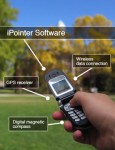
iPointer is a location-based application developed by Intelligent Spatial Technologies, which allows delivering on-demand information about the user location and surroundings.
From the company website:
"When users wish to identify a landmark, they point the hand-held device and press a button. The iPointer device receives coordinate signals from GPS satellites and orientation information from the digital magnetic compass to identify the user's location and device's pointing angle. These coordinates are then sent over the wireless network to the database. iST's geospatial database's selection algorithms identify the selected landmark and sends information back over the wireless network to be displayed in text, visuals and audio on the user's device"
20:28 Posted in Pervasive computing, Wearable & mobile | Permalink | Comments (0) | Tags: pervasive computing
Aug 04, 2006
Call for papers: Pervasive Computing in Healthcare
From the IEEE Pervasive Computing Journal website
Author guidelines: www.computer.org/pervasive/author.htm
Submission address: http://cs-ieee.manuscriptcentral.com
WIP Deadline: See below
Publication date: January 2007
IEEE Pervasive Computing invites articles about the use of pervasive computing technology in healthcare applications. We welcome papers that focus on novel applications of embedded sensor and actuators as well as user interfaces for use by caregivers and/or patients. We also encourage surveys of available technologies, and reporting on user experiences. Example topics include:
- Sensors and mobile devices for continuous patient monitoring
- Actuators and prompters for rehabilitation and behavior modification
- Mobile and wearable technologies for next generation drug trials
- Intelligent prosthetics
- Medical data-mining from health records
- Privacy architectures for medical records
- Applications for first responders including paramedics and emergency rooms
- Hospital work-flow management
- Intelligent implantable devices for applications in hearing, pain management, etc.
- Devices to monitor dietary intake and/or caloric expenditure
- Technologies for collaborative and/or competitive exercise support groups
- Issues in healthcare technology standards, interoperability, security, usability, cost, etc
Submissions should be 4,000 to 6,000 words long and should follow the magazine's guidelines on style and presentation. All submissions will be peer-reviewed in accordance with normal practice for scientific publications. Submissions should be received by 5 September 2006 to receive full consideration.
In addition to full-length submissions, we also invite work-in-progress submissions of 250 words or less (submit to mmraz@computer.org) These will not be peer-reviewed but will be reviewed by the Department Editor, Anthony Joseph, and, if accepted, edited by the staff into a feature for the issue. The deadline for work-in-progress submissions is 1 November 2006.
Walter Menning, Mayo Clinic
18:00 Posted in Call for papers, Pervasive computing | Permalink | Comments (0) | Tags: pervasive computing
Aug 02, 2006
Home-based sensors could detect early signs of dementia
Via Medgadget
According to a study conducted by Oregon Health & Science University researchers, continuous, unobtrusive monitoring of in-home activity may be a reliable way of assessing changes in motor behaviors that may occur along with changes in memory. The study was presented last week at the 10th International Conference on Alzheimer's Disease and Related Disorders in Madrid.
From the university's press release:
"To see a trend over time, you need multiple measures - good days and bad days - and it often takes years to see that trend in a clinic setting," said Tamara Hayes, Ph.D., assistant professor of biomedical engineering at OHSU's OGI School of Science & Engineering, and the study's lead author. She noted that most clinic visits by elders are spaced over months or even years, and their memory and motor skills performances are evaluated in a small number of tests completed in a limited amount of time.
"In contrast, we're looking continuously at elders' activity in their own homes," Hayes said. "Since we're measuring a person's activity many times over a short period, we can understand their normal variability and identify trends. If there's a change over a period, you can see it quickly. "
Mild cognitive impairment is a known risk factor for dementia, a neurological disorder most commonly caused by Alzheimer's disease. Changes in clinical measures of activity, such as walking and finger-tapping speeds, have been shown to occur at about the same time as memory changes leading to dementia. By detecting subtle activity changes over time in the natural setting of an elder's home, researchers hope to more effectively identify when elders are starting to have trouble.
11:40 Posted in Cybertherapy, Persuasive technology, Pervasive computing | Permalink | Comments (0)
May 10, 2006
Motiva
Philips has announced the launch of the remote monitoring system Motiva for the U.S. market (press release). The system is an interactive healthcare platform which uses broadband television, along with home vital sign measurement devices, to connect patients to their healthcare providers and medical support system.
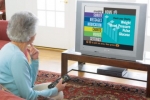
Motiva was the winner of a Medical Design Excellence Award and named one of the "Top 5 Disease Management Ideas of 2005"
22:00 Posted in Pervasive computing | Permalink | Comments (0) | Tags: Positive Technology
May 07, 2006
Existing Technologies Combine to Make Automated Home
Via Smart Mobs
 The National Institute of Advanced Industrial Science and Technology (Japan), Ymatic Ltd., and Biometrica Systems Asia Co. Ltd. have jointly developed a novel automated home. The home combines robots guided by IC tags, a biometric face authentication system, and a wireless network.
The National Institute of Advanced Industrial Science and Technology (Japan), Ymatic Ltd., and Biometrica Systems Asia Co. Ltd. have jointly developed a novel automated home. The home combines robots guided by IC tags, a biometric face authentication system, and a wireless network.
Source: Physorg
13:42 Posted in Pervasive computing | Permalink | Comments (0) | Tags: Positive Technology
Apr 20, 2006
New book about ubicomp
Via Smart Mobs
The Well's Inkwell Conference features a discussion with Adam Greenfield, author of Everyware:
Computing devices shrink ever smaller and become invisible, while at the same time we interact with them and they communicate with one another. Rather than carrying phones and PDAs, our desks, rooms, and clothing, our food and our sex toys converge, interconnect, and interact. Their connectedness is hidden from us, we don't control the information they record, and there's no "Undo" key."Great, another loopy novelist in the Inkwell, extrapolating from a random headline in a trade journal," you say.
It's not loopy fiction, according to Adam Greenfield. Instead, it's the form computing will take in the next few years, and it behooves us to think it through in advance, in order both to understand it and humanize it. That's the subject of "Everyware: The dawning age of ubiquitous computing."
Join Adam Greenfield from the beginning of the conversation or catch up on the latest posts
19:25 Posted in Pervasive computing | Permalink | Comments (0) | Tags: Positive Technology
Apr 11, 2006
New book about Ubiquitous Computing
Via Smart Mobs
Jon Lebkowsky (WorldChanging) interviews Adam Greenfield about his new book "Everyware: The Dawning Age of Ubiquitous Computing"
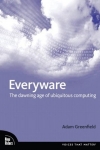 WorldChanging: So you're actually coming from a user experience perspective in your analysis of ubicomp?
WorldChanging: So you're actually coming from a user experience perspective in your analysis of ubicomp?
Adam Greenfield: That's the genesis of it, yeah. That was the real emotional hook for me, just thinking about people having to configure their toilets and people having to configure their teapots to boil a kettle of tea. And just
taking a direct analogy with the technical systems that are around us now - you know, dropped cellphone calls and the blue screen of death, and everything that we're familiar with from the PC and mobile infrastructure.
WorldChanging: The blue toilet of death! (Laughter.)
Adam Greenfield: Can you imagine? And I think what heightened the sense of urgency was that this stuff was moving beyond prototypes in short order. It was moving toward consumer products, toward the digital home and digital convergence. The products were starting to be packaged and shipped. And still nobody was talking about the nonlinear interactions of network systems in one space all operating at once - it's as if none of the people who were designing them had, not so much thought, but felt what it would be like to sit in the middle of a room where you've got fifteen different technical interfaces around you, and you're responding to all of them at once, and they're all responding to you at once.
A List Apart presents an introduction of Everyware. Free sample sections are available at the Everyware mini site.
20:50 Posted in Pervasive computing | Permalink | Comments (0) | Tags: Positive Technology
Feb 19, 2006
Ambient Intelligence: algorithms, methods and applications
9, 10 and 11 October 2006, at the 10th International Conference on Knowledge-Based & Intelligent Information & Engineering Systems:
This special session will focus on Artificial Intelligence techniques, essential for implementing AmI systems, complementing past workshops, which are generally oriented towards computer vision for the AmI paradigm.
Areas of interest include, but are not limited to:
- multi-agent methods,
- multi-sensor fusion,
- intelligent human-environment interaction,
- advanced human-computer interaction,
- conventional and embedded robotics solutions,
- ambient representation and innovative sensors
Notification of acceptance: 1 April 2006 Final papers to be received by: 1 May 2006
22:55 Posted in Pervasive computing | Permalink | Comments (0) | Tags: Positive Technology, ambient intelligence
Feb 14, 2006
Bio-inspired intelligent machines
Via Smart Mobs
The goal of the EU-funded SenseMaker project is to develop electronic architectures that embody the features of living perceptual systems and are able to merge sensory information obtained through different sensory modalities, into a unified perceptual representation of the environment. The architectural design of the SenseMaker machine will be based on biological principles of sensory receptor and nervous system function, inspired by experimental studies of several different sensory modalities.
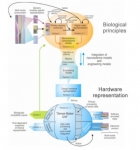
The system will include higher cognitive levels modelled on psychophysical research paradigms, whose function will be to implement dynamic rules of cross-modal integration, activity and time-dependent algorithms for internal prediction, goal directed attention, and transitions between dominant or convergent sensory modalities according to changing environmental parameters.
11:40 Posted in Pervasive computing | Permalink | Comments (0) | Tags: Ambient intelligence
Jan 14, 2006
Privacy, Trust and Identity Issues for Ambient Intelligence

Call for Papers--PERVASIVE 2006 WORKSHOP: Privacy, Trust and Identity Issues for Ambient Intelligence--Submissions are invited to this workshop, which will take place in Dublin, Ireland at the 4th International Conference on Pervasive Computing, May 7th--10th 2006. Deadline for submissions - 6th February 2006.
Privacy, trust and identity issues for ambient intelligence: Ambient Intelligence (AmI) has been described as a 'paradigmatic shift in computing and society' and has become one of the key concepts in the FP6 IST programme 2002-2006. However most of the current work on AmI is driven by technological concerns, despite claims that it is fundamentally a human-centred development that will essentially set people free from the desktop, hence it has been argued that the societal and user implications of AmI should be made more explicit.
One of the particular challenges of AmI, which marks it out from other E-Society developments, is that the user will be involved in huge numbers of moment-to-moment exchanges of personal data without explicitly sanctioning each transaction. Agent technologies will be required to manage the flow of information, and a great deal of exciting technical work is ongoing in this field. But personal and social concerns remain unanswered, particularly concerning issues of privacy, trust and identity. The AmI challenge is particularly pressing, since in future there will be no obvious physical markers to tell us when we move from private to public cyberspaces (Beslay and Punie, 2002) and so individuals must be given a clearer vision of how and when to control personal data.
For further details see here
Organising Committee: * Pamela Briggs (Northumbria) * Linda Little Northumbria) * Steve Marsh (NRC Canada) * Steve Love (Brunel) * Ishbel Duncan (St Andrews) * Tim Storer (St Andrews)
Contact: Professor Pamela Briggs, PACT Lab, Cognition and Communication Research Centre, Northumbria University, Newcastle upon Tyne, NE1 8ST
10:25 Posted in Pervasive computing | Permalink | Comments (0) | Tags: Positive Technology
Jan 13, 2006
Managing Multiple Spaces

A. Dix, A. Friday, B. Koleva, T. Rodden, H. Muller, C. Randell, A. Steed, Managing Multiple Spaces. In P. Turner, E. Davenport (eds.) Space, Spatiality and Technologies, Kluwer, 2005.
The authors' aim is analyse the way in which multiple spaces, both virtual and physical, can co-exist. By this we mean that people and objects may have locations in and relationships to both physical space and one or more virtual spaces, and that these different spaces together interact to give an overall system behaviour and user experience.
They use 4 cases (City, CityWide, the Drift Table and Ambient Wood) to see how multiple physical and virtual spaces interact. The choice of the different environment is pretty pertinent since there are mobile applications and an interactive table. They then discriminate 3 types of space: real space- the locations and activities of actual objects and people in physical space measured space - the representation of that space in the computer and the representation of locations of objects and people from sensor data, etc. virtual space - electronic spaces created to be portrayed to users, but not necessarily representing explicitly the real world. [...]
10:25 Posted in Pervasive computing | Permalink | Comments (0) | Tags: Positive Technology
Jan 12, 2006
Your Room as Browser
 From the website:
From the website:In effect, your whole room becomes a 'browser' that brings the experience to life. For example, PML-enabled lights add to the experience by getting brighter or dimmer, or changing colour. A PML-enabled hi-fi provides an appropriate soundscape. Almost any device can be PML-enabled: the possibilities are only limited by the imaginations of their manufacturers. Suppose a room is rendering an experience described as 'warm and sunny': the lights, the TV, the central heating, the electronically controlled blinds and (a little further into the future) even the ceiling, walls and floor coverings could all contribute to creating it.
10:19 Posted in Pervasive computing | Permalink | Comments (0) | Tags: Positive Technology, Ambient intelligence
Oct 13, 2005
Pervasive Health Conference
Pervasive Healthcare Conference 2006 will be held in Innsbruck, Austria (dates to be defined). Pervasive Healthcare is emerging both as a solution to many existing healthcare problems such as significant number of medical errors, considerable stress on healthcare providers, and partial coverage of healthcare services in rural and underserved areas worldwide, and as an opportunity to provide better healthcare services to an increasing number of people using limited financial and human resources.  Pervasive healthcare can be defined as healthcare to anyone, anytime, and anywhere by removing locational, time and other restraints while increasing both the coverage and quality of healthcare.
Pervasive healthcare can be defined as healthcare to anyone, anytime, and anywhere by removing locational, time and other restraints while increasing both the coverage and quality of healthcare.
Conference topics include, but are not limited to: technologies situated "on the patient", technologies situated "in the environment", medical aspects of pervasive healthcare, and management of pervasive healthcare.
For more information visit the conference website
![]() Tags: pervasive healthcare
Tags: pervasive healthcare
11:50 Posted in Pervasive computing | Permalink | Comments (0) | Tags: Positive Technology, Ambient intelligence
Jul 27, 2005
Ambient Experience for children undergoing MRI scan
Via Near Near Future
Ambient Experience for Healthcare is a program designed to lessen patient anxiety and claustrophobic effects of an MRI scan through the use of a multimedia environment. As soon as patients enter the MRI department, they are automatically identified by the system and the environment changes to match their personal features. Lighting and ambience of the room, as well as music and projections, can be adapted to match the specific needs of patients.

Patients can choose from four themes, each geared for different tastes and age groups; aquatic, space, fly-through and a default lava lamp type ambience. RFID-encoded cards corresponding to the theme chosen by patients cause the lighting and wall/ceiling projection to change in the exam room as they enter.
Ambient Experience was recently awarded a gold medal in the annual Industrial Design Excellence Award
10:45 Posted in Pervasive computing | Permalink | Comments (0) | Tags: Positive Technology, Ambient intelligence
Jul 21, 2005
Ubiquitous computing for cognitive decline
Cognitive decline is one of the most taxing health problems in terms of both its relation to elders' overall functioning and the cost of care. The loss of their abilities to use everything from a coffee maker to a computer may lead to social isolation, a decreased motivation, and increasing dependence on skilled support for assistance in routine activities. Prevention, early detection, and assistance for cognitive decline may be a useful application for ubiquitous computing technologies.
Ubicomp solutions typically involve multiple invisible devices embedded in the physical environment, all connected together to respond in transparent ways to the users in the context of everyday events. Ubicomp may match the challenge of providing elders pervasive support throughout the home, and adaptable levels of support.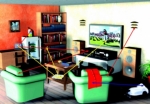
For example, Intel's Proactive Health Research initiative is exploring location and activity tracking technologies to support elders' indipendence and safety monitoring by caregivers. The programme also aims at investigating technologies that facilitate social connectedness and continuation of meaningful activities.
More to explore
Free full-text publications on pervasive computing
16:05 Posted in Pervasive computing | Permalink | Comments (0) | Tags: Positive Technology, Ambient intelligence
Mar 29, 2005
Captology: The science of Persuasive Technology
Can computers change what you think and do? Can they motivate you to stop smoking, persuade you to buy insurance, or convince you to join the Army?
The Stanford Persuasive Technology Lab, founded by BJ Fogg, an experimental psychologist, is trying to answer these questions. The lab creates insight into how computing products -- from websites to mobile phone software -- can be designed to change what people believe and what they do.
Like human persuaders, persuasive interactive technologies can bring about positive changes in many domains, including health, business, safety, and education. With such ends in mind, we are creating a body of expertise in the design, theory, and analysis of persuasive technologies, an area called "captology."
This is how Fogg describes the key concepts of his vision:
"Captology is the study of computers as persuasive technologies. This includes the design, research, and analysis of interactive computing products created for the purpose of changing people's attitudes or behaviors. As the graphic shows, captology describes the area where computing technology and persuasion overlap.
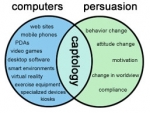
In the last few years we've seen this area grow quickly. Each week more computing products are designed to change what users think and do. We expect this trend to continue, especially as mobile phones become more capable of running third-party software applications.

We've identified over 100 uses for persuasive technology. Hundreds of other uses exist. Whenever there is a need to change what people believe or how they behave, persuasive technology may very well play a role"
More to explore
The web site of the Lab: http://captology.stanford.edu/
Fogg's book "Persuasive Technology"
18:15 Posted in Pervasive computing | Permalink | Comments (0) | Tags: Positive Technology, Ambient intelligence
Mar 23, 2005
Considerate computing
Ambient Intelligence will radically change how people interact with technology. In AmI, people will be surrounded by a multitude of interconnected embedded systems. These devices will be able to locate and recognize objects and people, as well as people’s intentions.
Following this view, AmI researchers are beginning to design computing devices that adapt the volume and timing of their communications to the cognitive needs of user. Such systems with a deep understanding of user attention have been referred to as Attentive User Interfaces
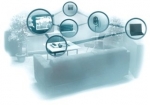
In AmI spaces these systems will proactively undertake speculative or anticipatory actions to hide the overall system complexity, by delivering to the users only information which is rich with meanings and contexts and provide stable functionality whenever requested
This article by Wayt Gibbs, recently published on Scientific American, show how engineers are testing computers, phones and cars that sense when you are busy and spare you from distractions...
More to explore
Attentive User Interfaces. Special section. Edited by Roel Vertegaal in Communications of the ACM, Vol. 46, No. 3, pages 30–72; March 2003.
Learning and Reasoning about Interruption. Eric Horvitz and Johnson Apacible. Proceedings of the Fifth International Conference on Multimodal Interfaces, November 2003. Proceedings of the International Workshop on Progress and Future Directions of Adaptive Driver Assistance Research. Washington, D.C., May 2004. Available online at www.volpe.dot.gov/opsad/saveit/
A variety of relevant technical articles are available online at http://interruptions.net
11:15 Posted in Pervasive computing | Permalink | Comments (0) | Tags: Positive Technology, Ambient intelligence
Dec 09, 2004
Optimal Experience & Ambient Intelligence

In the chapter that I have recently published in the book "Ambient Intelligence", I present a framework to evaluate user’s experience in AmI systems that stresses the role of attention in actively selecting information from the digital environment. Being a limited resource, attention forces the individual to focus on a restricted number of environmental or internal stimuli per time unit. Therefore, each individual effectively perceives only a small part of the available information. This form of psychological selection is driven a positive, complex and rewarding state of consciousness, called flow, or optimal experience. Starting from these premises, in the second part of the chapter I explain how optimal user experience in AmI systems may be assessed. In particular, I describe the Experience Sampling Method, a procedure that has been effectively used in various applied research domains.
20:10 Posted in Pervasive computing | Permalink | Comments (0) | Tags: Positive Technology, Ambient intelligence






